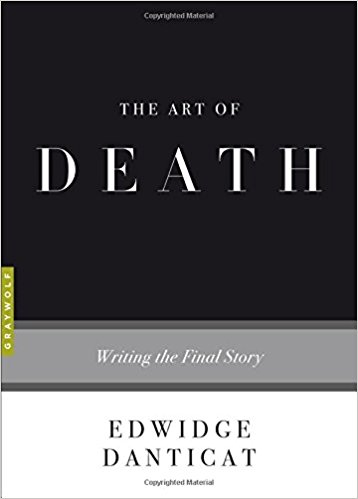Between the lines of death: The Art of Death: Writing the Final Story by Edwidge Danticat
Dana De Greff

Part philosophy, part criticism, part prayer, Danticat explores death both in real life and fiction; how some of us crave it while others fear it, and how all of us are always getting closer to it. In her introduction, she states “I am writing this book in order to learn (or relearn) how one writes about death, so I can write, or continue to write, about the deaths that have most touched my life, including, most recently, my mother’s.”
Sectioned into various essays such as “Living Dyingly,” “Circles and Circles of Sorrow,” and “Dying Together,” the book is a slim 160 pages, yet every word feels weighted. Held together by the stories about her mother both before and after her passing, Danticat also weaves in perspectives on death from other writers like Leo Tolstoy, Ta-Nehisi Coates, and Annie Dillard, such as how, when faced with the death of a loved one, communication gains new meaning: “Unlike ordinary talk, which can become routine, this kind of talk is pressing, urgent,” Danticat writes. “It has an expiration date, of which those who are caught up in the regular routine of life are not yet aware.”
Death is treated not merely as a fact of existence, but also as a character that appears in all of our lives. “How does one prepare to meet death elegantly?” Danticat asks herself and the reader at one point, and why is it that “[as] writers, we might seek the least elegant death possible for our characters, while we would want our loved ones to die ‘soft as cream’ as Toni Morrison writes in Beloved.”
Morrison is often quoted and her words analyzed in The Art of Death, alongside other notable writers such as Dylan Thomas, Gabriel García Márquez, Haruki Murakami, and Audre Lorde, powerful voices with varying thoughts and insights into the ever-enigmatic experience of dying. Reading, she seems to suggest, is one way to prepare ourselves. Danticat ruminates on her understanding of death as a concept, as well as the passing of family members, and those found in fiction, in film, and in the news, noting, “We write about the dead to make sense of our losses, to become less haunted, to turn ghosts into words, to transform an absence into language.”
And as painful as it is to lose a loved one, there are lessons to be gained in the struggle, especially if you happen to be a writer. As Annie Dillard put it in The Writing Life: “[…] assume you write for an audience consisting solely of terminal patients. That is, after all, the case. What would you begin writing if you knew you would die soon? What could you say to a dying person that would not enrage by its triviality?”
Death does do away with triviality, at least temporarily. When Danticat describes events like the earthquake that occurred in Haiti in 2010, families keeping vigil by rubble that trapped loved ones underneath, or the trauma of witnessing people dying en masse such as with September 11 and the Sandy Hook Elementary School shooting, we’re reminded “that we might all be here one day and be gone the next.” While suffering can feel, and can literally be unbearable in life, in literature the exact opposite is true. “Literature thrives on suffering,” Danticat writes. Writers need it to create tension and conflict, to use painful experiences for “some greater purpose.”
For a subject that’s so daunting to tackle, Danticat manages to distill death down to its core elements, writing on suicide, those condemned to die, close calls, and more. The penultimate section of The Art of Death culminates with a prayer written for a panel she was on at the 2015 PEN World Voices Festival of International Literature in New York, which was inspired by her mother’s dying and written from her point of view:
And please let the world go on. Let the sun still rise and set. Let the rain still fall, quiet and soft at times, and hard at other times. Let the oceans be still or roar, as they always have. Let the world go on as it always has, so that my children will know that only my spark has dimmed and not the entire world.
Meditative, sparse, and even funny, the prayer manages to accomplish everything Danticat does throughout The Art of Death: leave you wanting more, while knowing in your heart that what you were given was just enough.
Dana De Greff is the Founder & Executive Director of PageSlayers. She is currently at work on her first novel.









